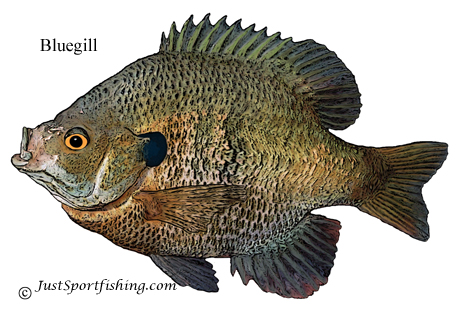|
|

How
to fish for Bluegill
The Bluegill is mainly a lake fish but are also found in slow moving creeks, rivers, farm ponds, reservoirs and swamps. Bluegill are usually found in shallower water but when water surface temperatures rise they head into deeper water. The Bluegill is native to the eastern half of the United States but has been widely introduced throughout the U.S. and many parts of the world. Bluegill average 8 inches and under 1/2 a pound. Bluegill feed on insects, worms, small minnows and crayfish.
A variety of tackle can be effective for catching bluegills, from a simple cane pole with a small hook and bobber to a fancy fly rod with a caddis fly. Small and lightweight is the best description for all bluegill fishing tackle. An ultralight spinning rod and reel is the best all around choice for most situations with 2 to 3 pound test line. If possible, do not use sinkers. However, it may be necessary to use a small split shot or slip weight to make a long cast. Try a 1/64-ounce or 1/32-ounce worm weight above a small bead attached to the line about 10 inches above the bait. If you choose to use a bobber, make it the smallest you can find.
Regardless of whether you prefer to use live bait or lures, you will need to keep them small if you want to catch a lot of Bluegill. Hook sizes from #6 to #10 are most effective. Hooks with long shanks will allow you to more easily remove them from the bluegill's tiny mouth and thin wire hooks work best for holding small baits. Live bait works especially well for bluegill. The most common baits are worms and night crawlers because they are readily available and are a proven bait for Bluegill . The key is to use only a piece of a worm - just enough to cover the hook . Other productive baits include crickets, grasshoppers, red wrigglers, and meal worms. Artificial lures also work well for bluegill. Some of the best lures are black jigs (1/32 ounce and smaller) and tiny spinners. Small flies and poppers are very effective and can be used while fly fishing or in conjunction with a bobber for easy casting.
If you are fly fishing for Bluegill you can use almost any dry fly or terrestrial and almost any nymph. There are also specially designed panfish popper flies, many of which can also be used with ultralight spinning tackle. The most popular terrestrial patterns are crickets, grasshoppers, foam spiders, and ants. A clever fly setup, especially at spawning time, is a panfish popper with a dropper line and a weighted nymph, such as a beadhead hare's ear. (This can be done using ultralight tackle, as well). Try popping and stopping at different speeds. When the fish are active, work the rig quickly and they'll strike the popper. When they're less active, just pop a few times and stop for up to 1 minute at a time. The nymph will swing down and suspend in front of their faces. For dry flies, remember that Bluegills may take much longer than trout to smack your fly. If you're not getting bites and you know the fish are there, try letting it sit a while longer, up to 1 minute at a time.

|
JustSportfishing.com

|


